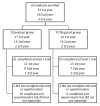A Randomized Comparative Trial of the Knowledge Retention and Usage Conditions in Undergraduate Medical Students Using Podcasts and Blog Posts
- PMID: 29552428
- PMCID: PMC5854316
- DOI: 10.7759/cureus.2065
A Randomized Comparative Trial of the Knowledge Retention and Usage Conditions in Undergraduate Medical Students Using Podcasts and Blog Posts
Abstract
Introduction Podcasts and blog posts have gained popularity in Free Open Access Medical education (FOAM). Previous work suggests that podcasts may be useful for knowledge acquisition in undergraduate medical education. However, there remains a paucity of research comparing the two mediums. This study aims to investigate if there are differences in knowledge acquisition and usage conditions by medical students using podcasts and blog posts. Methods Medical students were randomized to either the podcast or blog post group. They completed an initial online assessment of their baseline knowledge on the subject matter. Participants then received access to learning materials and were given four weeks to complete the follow-up assessment on their own time. Independent t-test, paired samples t-test, and a mixed ANOVA (analysis of variance) were conducted to assess knowledge acquisition. An intention-to-teach analysis was used to impute missing data from students lost to follow-up. Simple descriptive statistical data was used to describe media usage conditions. Results Completion of at least one follow-up assessment was comparable (68% podcasts (n = 21/31), 73% blog posts (n = 22/30)). Both groups showed significant improvements in their test scores, with an average 22% improvement for the podcast group and 29% for the blog post group. There was no significant statistical difference in knowledge acquisition between educational modalities overall. Students in the blog post group that completed both post-intervention quizzes showed a larger improvement than the podcast group in the toxicology topic, with similar improvements in the asthma topic. The podcast group tended to engage in multiple activities while using the learning materials (e.g. at least two to three of the following: driving, eating, chores, taking notes, exercising/walking), while the blog readers tended to do fewer activities (e.g. only one of the following: note taking, eating). Conclusion This study suggests that podcasts and blog posts are useful for extracurricular knowledge acquisition by undergraduate medical students with no significant difference between the two modalities. The usage conditions for each type of media differ.
Keywords: asynchronous education; blog posts; free medical online education; medical education; online learning resources; podcasts; undergraduate medical education.
Conflict of interest statement
The authors have declared that no competing interests exist.
Figures





Similar articles
-
Podcast Use in Undergraduate Medical Education.Cureus. 2017 Dec 9;9(12):e1930. doi: 10.7759/cureus.1930. Cureus. 2017. PMID: 29464137 Free PMC article.
-
ALiEM Blog and Podcast Watch: Toxicology.West J Emerg Med. 2017 Oct;18(6):1114-1119. doi: 10.5811/westjem.2017.6.33952. Epub 2017 Sep 11. West J Emerg Med. 2017. PMID: 29085545 Free PMC article.
-
Medical Education Blog and Podcast Utilization During the COVID-19 Pandemic.Cureus. 2022 Mar 21;14(3):e23361. doi: 10.7759/cureus.23361. eCollection 2022 Mar. Cureus. 2022. PMID: 35475051 Free PMC article.
-
Academic Life in Emergency Medicine (ALiEM) Blog and Podcast Watch: Renal and Genitourinary Emergencies.Cureus. 2018 Dec 20;10(12):e3756. doi: 10.7759/cureus.3756. Cureus. 2018. PMID: 30820376 Free PMC article. Review.
-
Learning Through Listening: A Scoping Review of Podcast Use in Medical Education.Acad Med. 2022 Jul 1;97(7):1079-1085. doi: 10.1097/ACM.0000000000004565. Epub 2022 Jun 23. Acad Med. 2022. PMID: 34935729 Free PMC article.
Cited by
-
Podcasting as a Learning Tool in Medical Education: Prior to and During the Pandemic Period.Balkan Med J. 2022 Sep 9;39(5):334-339. doi: 10.4274/balkanmedj.galenos.2022.2022-7-81. Epub 2022 Sep 6. Balkan Med J. 2022. PMID: 36065617 Free PMC article. Review.
-
An Evaluation of Emergency Medicine Core Content Covered by Podcasts.West J Emerg Med. 2023 Jan 11;24(1):15-22. doi: 10.5811/westjem.2022.11.57717. West J Emerg Med. 2023. PMID: 36735010 Free PMC article.
-
Leveraging Podcasts to Introduce Medical Students to the Broader Community of Health Care Professionals.MedEdPORTAL. 2021 Oct 25;17:11191. doi: 10.15766/mep_2374-8265.11191. eCollection 2021. MedEdPORTAL. 2021. PMID: 34754938 Free PMC article.
-
Establishment of an Undergraduate FOAM Initiative: International Emergency Medicine (iEM) Education Project for Medical Students.West J Emerg Med. 2020 Dec 16;22(1):63-70. doi: 10.5811/westjem.2020.10.48385. West J Emerg Med. 2020. PMID: 33439808 Free PMC article.
-
Enhancing Psychiatry Education through Podcasting: Learning from the Listener Experience.Acad Psychiatry. 2022 Oct;46(5):599-604. doi: 10.1007/s40596-022-01585-5. Epub 2022 Feb 2. Acad Psychiatry. 2022. PMID: 35107818
References
-
- Theoretical perspectives in medical education: Past experience and future possibilities. Mann KV. Med Educ. 2011;45:60–68. - PubMed
-
- Free Open Access Medical education (FOAM) for the emergency physician. Nickson CP, Cadogan MD. Emerg Med Australas. 2014;26:76–83. - PubMed
-
- What is the Net Generation? The challenge for future medical education. Sandars J, Morrison C. Med Teach. 2007;29:85–88. - PubMed
-
- Social media use in medical education: a systematic review. Cheston CC, Flickinger TE, Chisolm MS. Acad Med. 2013;88:893–901. - PubMed
LinkOut - more resources
Full Text Sources
Other Literature Sources
